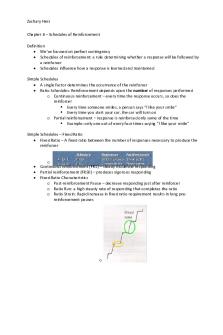Chapter 6 Utilization of constrained resources PDF

| Title | Chapter 6 Utilization of constrained resources |
|---|---|
| Course | Internet Scripting |
| Institution | University of Missouri-Kansas City |
| Pages | 3 |
| File Size | 100.4 KB |
| File Type | |
| Total Downloads | 58 |
| Total Views | 148 |
Summary
Download Chapter 6 Utilization of constrained resources PDF
Description
UTILIZATION OF CONSTRAINED RESOURCES • Anything that prevents an organization from getting more of what it wants (e.g., profits) is a constraint. • A particular machine may not have enough capacity to satisfy current demand. • Supplies of a critical part may not be sufficient to satisfy current demand. • When the constraint is a machine or a work center, it is called a bottleneck. • When capacity is not sufficient to satisfy demand, something must be cut back. Which products should be cut back and by how much? • Fixed costs are not usually affected by the decision of which products should be emphasized in the short run. All of the machines and other fixed assets are in place—it is just a question of how they should be used. • When fixed costs are unaffected by the choice of which product to emphasize, maximizing the total contribution margin will also maximize total profits. • The total contribution margin is maximized by emphasizing the products with the greatest contribution margin per unit of the constrained resource. EXAMPLE: Ensign Company makes two products, X and Y. The current constraint is Machine N34. Selected data on the products follow: Selling price per unit........................................ Less variable expenses per unit........................ Contribution margin.........................................
X $60 36 $24
Y $50 35 $15
Contribution margin ratio.................................
40%
30%
Current demand per week (units).....................
2,000
2,200
Processing time required on Machine N34 per unit
1.0 minute
0.5 minute
Machine N34 is available for 2,400 minutes per week, which is not enough capacity to satisfy demand for both product X and product Y. Should the company focus its efforts on making product X or product Y?
CM PER UNIT OF THE CONSTRAINED RESOURCE Contribution margin per unit (a)..................... Constrained resource required to produce one unit (b).................................................. Contribution margin per unit of the constrained resource (a)÷ (b).......................
X $24
Y $15
1.0 minute
0.5 minute
$24 per minute
$30 per minute
• Product Y should be emphasized because it has the larger contribution margin per unit of the constrained resource. A minute of processing time on Machine N34 can be used to make 1 unit of Product X, with a contribution margin of $24, or 2 units of Product Y, with a combined contribution margin of $30. • In the absence of other considerations (such as satisfying an important customer), the best plan would be to produce to meet current demand for Product Y and then use any remaining capacity to make Product X.
ALLOTING THE CONSTRAINED RESOURCE Total time available on Machine N34 (a)...................................
2,400 minutes
Planned production and sales of Product Y............................... Time required to process one unit.............................................. Total time required to make Product Y (b).................................
2,200 units × 0.5 minute 1,100 minutes
Time available to process Product X (a) – (b)........................... Time required to process one unit..............................................
1,300 minutes ÷ 1 minute per unit 1,300 units
Planned production and sales of Product X............................... RESULTS OF FOLLOWING THE ABOVE PLAN
Planned production and sales (units)......................... Contribution margin per unit..................................... Total contribution margin..........................................
X 1,300 × $24 $31,200
Y 2,200 × $15 $33,000
Total
$64,200
UTILIZATION OF CONSTRAINED RESOURCES (continued)
MANAGING CONSTRAINTS Processing more good units through the bottleneck that customers actually want is a key to increased profits: • Produce only what can be sold. • Pay workers overtime to keep the bottleneck running after normal working hours. • Shift workers from non-bottleneck areas to the bottleneck. • Hire more workers or acquire more machines for the bottleneck. • Subcontract some of the production that would use the bottleneck. • Focus business process improvement efforts such as Six Sigma on the bottleneck. • Reduce defects. The potential payoff to effectively managing the constraint can be enormous.
EXAMPLE: Suppose the available time on Machine N34 can be increased by paying the machine’s operator to work overtime. Would this be worthwhile? ANSWER: Since the additional time would be used to make more of Product X, each minute of overtime is worth $24 to the company and hence each hour is worth $1,440 (60 minutes × $24 per minute)!...
Similar Free PDFs

ELECTRICAL POWER UTILIZATION NOTES
- 171 Pages

Unit 3 Vocab 6 - Resources
- 2 Pages

Constrained Vision Essay
- 4 Pages

UEE UNIT-1 notes of utilization
- 18 Pages

Chapter 6: Elements of crimes
- 4 Pages

Chapter 6 Analysis of Structures
- 43 Pages
Popular Institutions
- Tinajero National High School - Annex
- Politeknik Caltex Riau
- Yokohama City University
- SGT University
- University of Al-Qadisiyah
- Divine Word College of Vigan
- Techniek College Rotterdam
- Universidade de Santiago
- Universiti Teknologi MARA Cawangan Johor Kampus Pasir Gudang
- Poltekkes Kemenkes Yogyakarta
- Baguio City National High School
- Colegio san marcos
- preparatoria uno
- Centro de Bachillerato Tecnológico Industrial y de Servicios No. 107
- Dalian Maritime University
- Quang Trung Secondary School
- Colegio Tecnológico en Informática
- Corporación Regional de Educación Superior
- Grupo CEDVA
- Dar Al Uloom University
- Centro de Estudios Preuniversitarios de la Universidad Nacional de Ingeniería
- 上智大学
- Aakash International School, Nuna Majara
- San Felipe Neri Catholic School
- Kang Chiao International School - New Taipei City
- Misamis Occidental National High School
- Institución Educativa Escuela Normal Juan Ladrilleros
- Kolehiyo ng Pantukan
- Batanes State College
- Instituto Continental
- Sekolah Menengah Kejuruan Kesehatan Kaltara (Tarakan)
- Colegio de La Inmaculada Concepcion - Cebu









